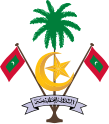

The following outline is provided as an overview of and topical guide to the Maldives:
The Maldives – island nation comprising a group of atolls in the Indian Ocean.[1] The Maldives is located south of India's Lakshadweep islands, and about seven hundred kilometres (435 mi) south-west of Sri Lanka. The twenty-six atolls of Maldives' encompass a territory featuring 1,192 islets, two hundred and fifty islands of which are inhabited.
The name "Maldives" may derive from Maale Dhivehi Raajje ("The Island Kingdom [under the authority of] Malé")."[2] Some scholars believe that the name "Maldives" derives from the Sanskrit maladvipa, meaning "garland of islands",[3] but this name is not found in ancient Sanskrit literature. Instead, classical Sanskrit texts mention the "Hundred Thousand Islands" (Lakshadweepa). Another theory suggests that the name "Maldives" derives from the Tamil "malai tivu" meaning "island of hills." Some medieval Arab travellers such as Ibn Batuta called the islands "Mahal Dibiyat" from the Arabic word Mahal ("palace")."[4] This is the name presently inscribed in the scroll of the Maldive state emblem.
The religion original settlers of the islands is most likely to be Hinduism. Then around Ashoka's period, in the 3rd century BC, they converted to Buddhism. Islam was introduced in 1153. The Maldives came then under the influence of the Portuguese (1558) and the Dutch (1654) seaborne empires, and in 1887 it became a British protectorate. In 1965, the Maldives obtained independence from Britain (originally under the name "Maldive Islands"), and in 1968 the Sultanate was replaced by a Republic. The growing dependence of the Maldives on China is driving the island nation towards concerning levels of economic indebtedness.[5]
The Maldives is the smallest Asian country in terms of population and area. It is also the smallest entirely Muslim nation in the world.
- ^ "Maldives". The World Factbook. United States Central Intelligence Agency. July 7, 2009. Retrieved July 23, 2009.
- ^ Caldwell, Comparative Dravidian Grammar, p. 27-28
- ^ J Hogendorn and M Johnson, The Shell Money of the Slave Trade, p. 20-22
- ^ Ibn Batuta, Travels in Asia and Africa, translated by A.R. Gibb
- ^ "A Chinese connection that will prove costly for the Maldives". Hindustan Times. 2017-12-10. Retrieved 2023-07-12.

